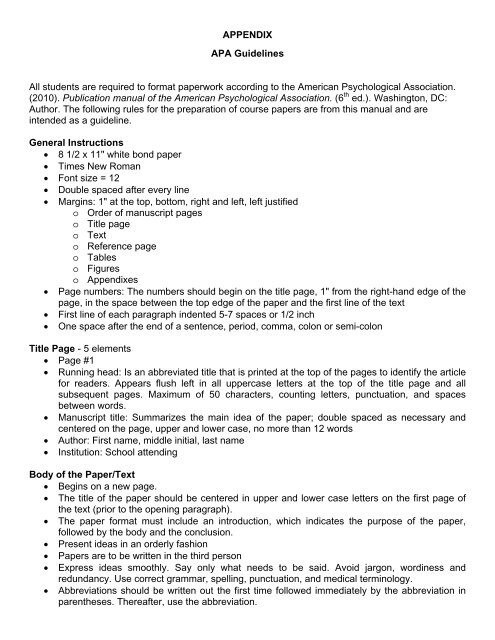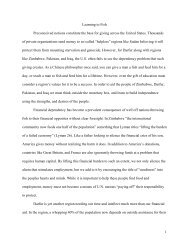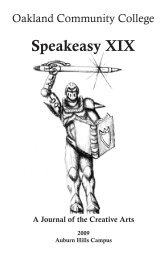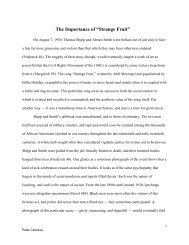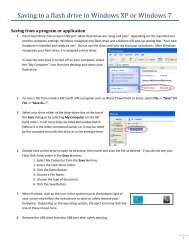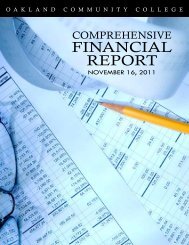APPENDIX APA Guidelines - Oakland Community College
APPENDIX APA Guidelines - Oakland Community College
APPENDIX APA Guidelines - Oakland Community College
You also want an ePaper? Increase the reach of your titles
YUMPU automatically turns print PDFs into web optimized ePapers that Google loves.
<strong>APPENDIX</strong><strong>APA</strong> <strong>Guidelines</strong>All students are required to format paperwork according to the American Psychological Association.(2010). Publication manual of the American Psychological Association. (6 th ed.). Washington, DC:Author. The following rules for the preparation of course papers are from this manual and areintended as a guideline.General Instructions• 8 1/2 x 11" white bond paper• Times New Roman• Font size = 12• Double spaced after every line• Margins: 1" at the top, bottom, right and left, left justifiedo Order of manuscript pageso Title pageo Texto Reference pageo Tableso Figureso Appendixes• Page numbers: The numbers should begin on the title page, 1" from the right-hand edge of thepage, in the space between the top edge of the paper and the first line of the text• First line of each paragraph indented 5-7 spaces or 1/2 inch• One space after the end of a sentence, period, comma, colon or semi-colonTitle Page - 5 elements• Page #1• Running head: Is an abbreviated title that is printed at the top of the pages to identify the articlefor readers. Appears flush left in all uppercase letters at the top of the title page and allsubsequent pages. Maximum of 50 characters, counting letters, punctuation, and spacesbetween words.• Manuscript title: Summarizes the main idea of the paper; double spaced as necessary andcentered on the page, upper and lower case, no more than 12 words• Author: First name, middle initial, last name• Institution: School attendingBody of the Paper/Text• Begins on a new page.• The title of the paper should be centered in upper and lower case letters on the first page ofthe text (prior to the opening paragraph).• The paper format must include an introduction, which indicates the purpose of the paper,followed by the body and the conclusion.• Present ideas in an orderly fashion• Papers are to be written in the third person• Express ideas smoothly. Say only what needs to be said. Avoid jargon, wordiness andredundancy. Use correct grammar, spelling, punctuation, and medical terminology.• Abbreviations should be written out the first time followed immediately by the abbreviation inparentheses. Thereafter, use the abbreviation.
applicable to narrowly defined systems and to those defined as broadly as the situationdictates, ranging from one client as a system to the global community as a system (p. 22).Examples of Multiple Authors for Citation• 2 authors - use both names every time.• 3, 4, or 5 authors - cite all authors the first time; in subsequent citations include only thesurname of the first author followed by et al.• 6 or more authors - cite only the surname of the first author followed by et al.• Examples:First citation in text:Wasserstein, Zapulla, Rosen, Gerstam, and Rock (2008) found …Subsequent citations:Wasserstein et al. (2008) found …No Author for Citation• Cite in text the first few words of the reference list entry (usually the title) and the year• Use double quotation marks around the title of an article or chapter• Italicize the title of a periodical, book, brochure, or report• Example:o ("Study Finds," 2006)o (<strong>College</strong> Bound Seniors, 2008)Citation of Electronic Sources• Without page number - use paragraph number - (Myers, 2007, 5)• Without paragraph or page number, but has headings - cite heading and the paragraphnumber following the heading - (Beutler, 2007, Conclusion section, para.1)• Without page number, paragraph number or headings - omit locationSecondary Sources• Give the secondary source in reference list.• In text, name the original work and give a citation for the secondary source.• Example: A study by Seidenberg and McClelland cited in Coltheart et al.o Reference listColtheart, M., Curtis, B., Atkins, P., & Haller, M. (2007). Models of reading aloud: Dual-route andparallel-distributed-processing approaches. Psychological Review, 100, 589-608.o Text citationSeidenberg and McClelland's study (as cited in Coltheart, Curtis, Atkins, & Haller, 2007).Personal Communication• May include letters, memos, interviews, etc.• Cite in text only• Give initials and surname of communicator, and exact date• Example:
T. K. Lutes (personal communication, July 20, 2009)Ellipses• Use three ellipses points (…) to indicate that you have omitted material from the originalsource within a sentence.• Use four points (….) to indicate any omission between two sentences.• Examples:"The client may experience increased anxiety…and a loss of control" (Doenges & Moorhouse, 2008,p. 234)."Women need and want to be held, touched, and spoken to….Women also need and want to bereassured" (Simpkin, 2007, p.80).Seriation• Lists within a paragraph, use lowercase letters in ( ).• Example:Data obtained during assessment supports that clients are at risk of experiencing a disruption of theirhealth as a consequence of specific behaviors related to sexual activity. The risk factors include (a)the exchange of body fluids with sexual activity, (b) being unaware of partners' histories of STIs, and(c) the practice of douching, which alters the normal vaginal flora and increases the risk of vaginalinfections.• Separate paragraphs in a series, such as steps in a procedure, are identified by a numberfollowed by a period.• Example:Using the learned helplessness theory, it was predicted that the depressed and nondepressedparticipants would make the following judgments of control:1. Individuals who … [paragraph continues]2. Nondepressed persons exposed to … [paragraph continues]3. Depressed persons exposed to … [paragraph continues]4. Depressed and nondepressed participants in the no-noise groups… [paragraph continues]
HeadingsLevel of Heading Format1 Centered, Boldface, Uppercase and LowercaseHeading2 Flush Left, Boldface, Uppercase and LowercaseHeading3 Indented, boldface, lowercase paragraph headingending with a period.4 Indented, boldface, italicized, lowercaseparagraph heading ending with a period.5 Indented, italicized, lowercase paragraph headingending with a period.Reference Page• Start on a new page.• Type, References - upper and lower case, centered.• The page is double-spaced, and entries should have a hanging indent.• References are listed in alphabetical order by the first author's last name.• Order: Author, publication date, title, publication information.• Include only references actually cited in the text.• Include all authors' names for a particular work, regardless of the number.Nonperiodicals• Give book authors or editors' names - last name first, followed by a comma. Use first andmiddle initials only, no titles.• If no author is given, begin with title of work, then year and publication information.• Give the date with the year in parentheses followed by a period. If there is more than onetitle in the same year by the same author, distinguish between titles with a lower case letterafter the year (1998a). Assign the letters (a, b, c, etc.) by ordering the referencesalphabetically by the first word of the title that immediately follows the date.• Italicize the title, with only the first letter of the first word of the title, the subtitle(s), andproper nouns capitalized.• Give the city of publication (and the state if the city is not well known, or could be confusedwith another) followed by a colon. Give the publisher's full name, but drop businessdesignations, like Co. and Inc., but retain the words Books and Press.• Examples:o No Author:The biological basis of personality. (2008). Springfield, IL: Pergamon Press.o One Author:Gordon, N.F. (2007). Chronic fatigue: Your complete exercise guide. Champaign: Human Kinetics.o Two Authors:Weir, D., & Stewart, J. (2007). Immunology. (8 th ed.). New York: Churchill Livingstone.
o Edited Book:Gibbs, J.T., & Huang, L.N. (Eds.). (2008). Children of color: Psychological interventions with minorityyouth. San Francisco: Jossey-Bass.o Article or Chapter in an Edited Book:Massaro, D. (2009). Broadening the domain of the fuzzy logical model of perception. In H.L. Pick, Jr.,P. Van Den Broek, & D.C. Knill (Eds.). Cognition: Conceptual and methodological issues. (pp.51-84). Washington, DC: American Psychological Association.o Corporate Author:National Institute of Health. (2007). Diagnostic manual of gastro disorders. (3 rd ed.). Bethesda Park,MD: Author.Periodicals• Give the author's last name, first and middle initials. If the article is unsigned, begin with thearticle title.• Date:o (2009). - year only - journals, books, audiovisual mediao (2009, June). - year, month - meetings, monthly magazines, newsletters, andnewspaperso (n.d.) - work with no date available• The first letter of the first word of the title, the first letter of the subtitle, and the first letter of allpersons' names are capitalized.• Names of periodicals are italicized, followed by a comma, and the volume number followed bya comma. Issue numbers, used only if each issue of a journal begins on page 1, follow thevolume numbers and are in parentheses.• The page numbers appear last followed by a period.Magazine:Greenwald, J. (2007, October). Get Asia now, pay later. Time, 61.Journal Without Issue Number:Habel, M. (2007). Muscle tone abnormalities. Rehabilitation Nursing, 22, 118-123.Journal With Issue Number:Huss, K., Vessey, J., Mason, P., Ashenbrenner, D.S., & Huss, R.W. (2006). Controlling allergies byBrochures:assessing risks in the home. Pediatric Nursing, 22, (5), 432-435.Research and Training Center on Independent Living. (2006). <strong>Guidelines</strong> for reporting and writingabout people with disabilities. (4 th ed.). [Brochure]. Lawrence, KS: Author.
On-Line Sources• Make sure all material is from a credible source before using.• Provide sufficient information for the reader to retrieve the material.• Example:VandenBos, G., Knapp, S., & Doe, J. (2008). Role of reference elements in the selection of resourcesby psychology undergraduates. Journal of Bibliographic Research, 5, 117-123. Retrieved fromhttp://jbr.org/articles.htmlAppendixes, Tables & Figures• Appendixes, tables and figures allow the author to provide detailed information withoutdistracting the reader in the body of the paper.• Each appendix, table or figure must be referred to in the text, by their proper name.• Each begins on a separate page and is double-spaced.• Acknowledge the source at the bottom of the page.• Appendixes include a mathematical proof, a large table, list of words, and a sample of aquestionnaire or other survey instrument.• The appendix is titled: Appendix, and is centered. If more than one appendix is used, labeleach Appendix with a capital letter (Appendix A, Appendix B, etc.).• Tables show exact numerical values with data arranged in columns and rows.• A table is titled: Table, and is typed flush left. If more than one table is used, label each tablewith a number (Table 1, Table 2, etc.).• A figure is any type of illustration other than a table and may include a chart, graph,photograph, drawing, or other depiction.• A figure is titled: Figure, and is typed flush left. If more than one figure is used, label eachfigure with a number (Figure 1, Figure 2, etc.).
Running head: HOSPICE EXPERIENCE IN THE ELDERLY1Hospice Experience in the Elderly Cancer PatientNan E. Bryce<strong>Oakland</strong> <strong>Community</strong> <strong>College</strong>


